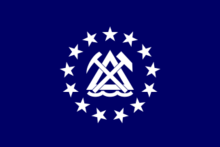USGS

Seal of the United States Geological Survey
|
|

Official identifier of the U.S. Geological Survey
|
|
 Flag of the United States Geological Survey |
|
| Agency overview | |
|---|---|
| Formed | March 3, 1879 |
| Jurisdiction | United States |
| Headquarters |
Reston, Virginia United States 38°56′51″N 77°22′06″W / 38.9475194°N 77.3683075°WCoordinates: 38°56′51″N 77°22′06″W / 38.9475194°N 77.3683075°W |
| Employees | 8,670 (2009) |
| Annual budget | $1.1 billion (FY2010) |
| Agency executive |
|
| Parent agency | United States Department of the Interior |
| Website | USGS.gov |
The United States Geological Survey (USGS, formerly simply Geological Survey) is a scientific agency of the United States government. The scientists of the USGS study the landscape of the United States, its natural resources, and the natural hazards that threaten it. The organization has four major science disciplines, concerning biology, geography, geology, and hydrology. The USGS is a fact-finding research organization with no regulatory responsibility.
The USGS is a bureau of the United States Department of the Interior; it is that department's sole scientific agency. The USGS employs approximately 8,670 people and is headquartered in Reston, Virginia. The USGS also has major offices near Lakewood, Colorado, at the Denver Federal Center, and Menlo Park, California.
The current motto of the USGS, in use since August 1997, is "Science for a changing World." The agency's previous slogan, adopted on the occasion of its hundredth anniversary, was "Earth Science in the Public Service."
Prompted by a report from the National Academy of Sciences, the USGS was created, by a last-minute amendment, to an act of Congress on March 3, 1879. It was charged with the "classification of the public lands, and examination of the geological structure, mineral resources, and products of the national domain". This task was driven by the need to inventory the vast lands added to the United States by the Louisiana Purchase in 1803 and the Mexican–American War in 1848.
...
Wikipedia
